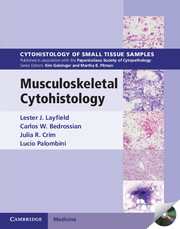Book contents
- Frontmatter
- Contents
- 1 Principles and practice for biopsy diagnosis and management of musculoskeletal lesions
- 2 Ancillary techniques useful in the evaluation and diagnosis of bone and soft tissue neoplasms
- 3 Spindle cell tumors of bone and soft tissue in infants and children
- 4 Spindle cell tumors of the musculoskeletal system characteristically occurring in adults
- 5 Giant cell tumors of the musculoskeletal system
- 6 Myxoid lesions of bone and soft tissue
- 7 Lipomatous tumors
- 8 Vascular tumors of bone and soft tissue
- 9 Pleomorphic sarcomas of bone and soft tissue
- 10 Osseous tumors of bone and soft tissue
- 11 Cartilaginous neoplasms of bone and soft tissue
- 12 Small round cell neoplasms of bone and soft tissue
- 13 Epithelioid and polygonal cell tumors of bone and soft tissue
- 14 Cystic lesions of bone and soft tissue
- Index
8 - Vascular tumors of bone and soft tissue
Published online by Cambridge University Press: 05 September 2013
- Frontmatter
- Contents
- 1 Principles and practice for biopsy diagnosis and management of musculoskeletal lesions
- 2 Ancillary techniques useful in the evaluation and diagnosis of bone and soft tissue neoplasms
- 3 Spindle cell tumors of bone and soft tissue in infants and children
- 4 Spindle cell tumors of the musculoskeletal system characteristically occurring in adults
- 5 Giant cell tumors of the musculoskeletal system
- 6 Myxoid lesions of bone and soft tissue
- 7 Lipomatous tumors
- 8 Vascular tumors of bone and soft tissue
- 9 Pleomorphic sarcomas of bone and soft tissue
- 10 Osseous tumors of bone and soft tissue
- 11 Cartilaginous neoplasms of bone and soft tissue
- 12 Small round cell neoplasms of bone and soft tissue
- 13 Epithelioid and polygonal cell tumors of bone and soft tissue
- 14 Cystic lesions of bone and soft tissue
- Index
Summary
INTRODUCTION
Vascular neoplasms demonstrate a wide range of morphologies and behaviors ranging from benign hemangiomas to aggressive, rapidly fatal angiosarcomas. Vascular proliferations may be congenital or non-congenital with fundamentally different etiologies, clinical presentations, and therapeutic implications. Some lesions are congenital malformations and not neoplastic. Other congenital lesions are clinically inapparent at birth but become significant in young adulthood. A number of hemangiomas and hemangioendotheliomas regress as the patient ages. Whether these lesions are truly neoplastic or not is debated. A number of growth factors appear to be important in angiogenesis. Among these are vascular endothelial growth factors A and B (VEGF A and B) and fibroblast growth factor (FGF). Prostaglandin E2, interleukin-8, and platelet derived growth factor also appear to play roles in angiogenesis.
HEMANGIOMA
Clinical features
Hemangiomas are one of the most common soft tissue tumors representing between 7 and 10% of all benign mesenchymal lesions. These neoplasms most commonly come to clinical attention during infancy and childhood when there is a predilection for their formation in the head and neck region. In adults, hemangiomas take the form of capillary or cavernous lesions and are more common in women. They may fluctuate in size during pregnancy and menarche suggesting the importance of estrogen and progesterone in their growth. While hemangiomas may persistently grow, they do not undergo malignant transformation. However, extremely well differentiated cutaneous angiosarcomas and angiosarcomas of the breast exist which are neoplasms fully capable of metastasis but typically morphologically difficult to distinguish from benign hemangiomas.
- Type
- Chapter
- Information
- Musculoskeletal Cytohistology , pp. 165 - 182Publisher: Cambridge University PressPrint publication year: 2000



